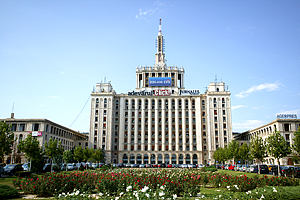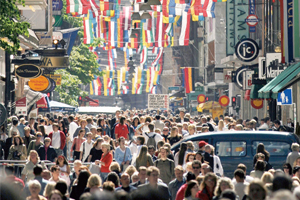
SHOPPING AND CRISIS
I got caught, the other day, in such an indescribable crowd in one of Bucharest’s shopping malls, for a moment I thought I was in America. People were in something of a shopping frenzy.
A few days later, the same place was dead quiet. The salesclerks were dozing behind the shelves while the few shoppers were loitering spiritlessly, insofar as I could hardly recognize the place I had recently visited, one so full of life and… economy. What is happening? With most advanced economies – the ones in the Western world, North America, Japan, or wherever else they might be – taking the pulse of the economy is a relatively simple endeavour: just watch how shopping goes in a mall. If the place is full, if people are buying, wares are circulating apace, then all’s well.
Nowhere is this dependency of economy on retail, on actual consumption clearer than in the United States. A good sales day is a good day for the economy. In Europe, things are a little more complicated than that. For a country like Germany, for instance, where exports play a key role in raising the economy, consumption is not as important. As a matter of fact, the whole of Europe wishes Germans would get Americans’ insatiable consumerism, as they would set the tone for the entire continent. But they don’t (have it).
Nor do the French, not any more. A salesperson in one of France’s international chains was recently quoted in the Wall Street Journal complaining about the average French person’s lack of appetite (or rather lack of possibilities) for consumption. The only saving grace was the fact that tourists visiting Paris unavoidably end up visiting the city’s shops. All in all, the sales and consumption experience paints a fairly accurate pictures of the general state of the economy in a given country, with the moderate comeback in the United States, the German level-headed discipline, but also their prosperity, or with the onsetting recession in France. How are things, then, in Romania? What can be concluded based on what goes on in the malls? Is consumption capable of raising the economy? Romanian imports have effectively collapsed during the past few years.
German-made cars are still being admired, but second hand ones are the ones getting bought, Romanian foodstuffs are suddenly preferred to their foreign counterparts and the most noticeable thing about large international brands has, in recent times, been the increasing number of commercial properties they have left vacant on Calea Victoriei. Still, the last trimester has produced positive figures translating, statistically speaking, as consume. This was the period when I saw all those people in shops. Some increased pay checks, some spring warming… Yes, but all that is not enough to explain the 2 %extra in consumption, nor the 0.5% GDP increase.
So I carefully checked all the indicators: the lower energy consumption, the slight growth of the industrial production, the exports that stayed on par with those from the previous semester. Whence, then, comes this economic growth in Romania? It’s odd, to say the least, but during this time some 2 billion Euros have entered the country, of which a mere 200 million or so are from direct foreign investments.
From an accounting standpoint, they come under the “transfers” section: money sent from outside the borders, money that goes in already existing businesses, investment funds attracted by a country whose parameters are improving, as the propitious exchange rate favoured those betting on the Romanian currency. A mottled mix of intents and conditions leading to one great shopping day, and several confuse ones; to growth, but a random, unpredictable one; to hopes, but no certainties; and causing malls to remain just what they are supposed to be: a place for shopping, rather than one of dreams… a space of pragmatism, not hope. There’s a long way ahead, before predictable growth, certitudes and dreams, and many confuse days to come in the Romanian malls. And, sadly, not just in the malls.









